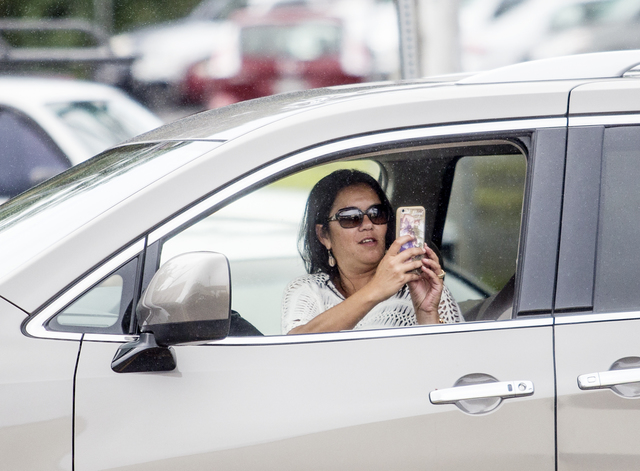HILO — From the beginning of 2014 until mid-April this year, the Hawaii Police Department issued a total of 5,904 citations for the use of a mobile electronic device while driving. ADVERTISING HILO — From the beginning of 2014 until
HILO — From the beginning of 2014 until mid-April this year, the Hawaii Police Department issued a total of 5,904 citations for the use of a mobile electronic device while driving.
Big Island police issued 2,904 citations in 2014, 2,297 in 2015, and 703 in this year’s count provided by the department.
The largest number of tickets written during the two-years-plus period, 2,342, was in Kona, while Hilo drivers received 1,932 citations. Officers cited 599 violations in South Kohala, 593 in Puna, 180 in Hamakua, 99 in North Kohala, 82 in North Hilo and 73 in Ka‘u.
Police received federal grant money last month to fund additional checkpoints in a campaign called “U Drive U Text U Pay.” It was publicized by a 30-second national television spot showing a teenage girl driving with three friends as passengers. She hears a tone from her cellphone and replies to a text message, causing her to run a stop sign. A tractor-trailer truck violently plows broadside into her car, sending the vehicle plummeting off a freeway overpass.
The cellphone, its screen broken, is shown on the pavement next to the wreckage. A police officer picks up the phone, turns to the camera and says, “Nobody likes to be stopped by the police. But if I’d seen her texting while driving, I’m giving her a ticket. It just might have saved her life.”
“I still constantly see people texting, using their phones, there’s still many violations out there,” Sgt. Robert Pauole, head of the department’s Traffic Services Section, said late last week. “The most dangerous behavior, of course, is texting, because drivers are looking downward. Their eyes are off the roadway for a second or so, which is the biggest issue in distracted driving. … Texting and driving is the worst, the biggest distraction.”
In fact, the phenomenon has entered the realm of pop-culture slang with the term “driving while intexticated.” Although the TV ad used teenagers to get its message across, Pauole said the illegal use of electronic devices while driving isn’t restricted to youthful motorists.
“It’s across the board. You would think it would be just the younger crowd, but it varies,” he said. “In fact, I just did a checkpoint this past weekend and we were catching all different ages. We caught one guy in a checkpoint that we’d gotten before for a seat belt. This time, he was wearing his seat belt, but he was on the phone. I think he was in his 60s.”
The penalty for using a mobile device while driving is $297, with a $307 fine if the device is used in a school or construction zone.
“I’m just so surprised people are shocked when I’m giving them a $300 citation,” Pauole said. “The cellphone violation has been $300 dollars for awhile. And we’ve put out media releases. It’s $300 and they still use (the cellphone). And they still use it, texting. It’s shocking that people still use their phones that much.
“I play this game with my kids. I live two miles from their school. And in the two miles, I can find two violations, either seat belt or cellphone use. Taking my kids to school or back, I can find two violations every time. It’s automatic. That’s how often people are not using their seat belts or are on their cellphone. And that’s a lot.”
The law makes legitimate 911 calls by drivers a so-called “affirmative defense” if they’re ticketed, and there’s an exemption for drivers 18 and older using hands-free cellular devices, such as Bluetooth.
“What I always tell someone who is pulled over for a cellphone violation is, ‘For $297, almost $300, you can go to any store or shop and buy a new car stereo system that has Bluetooth capability for less than that,’” Pauole said. “All these new car stereo systems now come with Bluetooth, so when your phone rings, it comes over the speaker on the stereo, and you can talk.”
Drivers under 18 still aren’t allowed to use mobile electronic devices while driving, including hands-free devices.
Exceptions to the law are also made for emergency responders, such as police and fire personnel, in the official commission of their duties.
The law, Hawaii Revised Statutes 291C-137, states that drivers who use a mobile electronic device must be at “a complete stop, while the engine is turned off, in a safe location by the side of the road out of the way of traffic.”
“Driving and texting is not only dangerous and irresponsible — it’s illegal,” said Hawaii Police Chief Harry Kubojiri. “Drivers who break our state’s texting law will be stopped and fined. This is a major problem in our country, and we’re trying to work toward a resolution whereby all motorists voluntarily comply with this law to avoid being fined, ultimately making our roadways safer for all.
“If you drive and text, you will pay.”
Email John Burnett at jburnett@hawaiitribune-herald.com.



